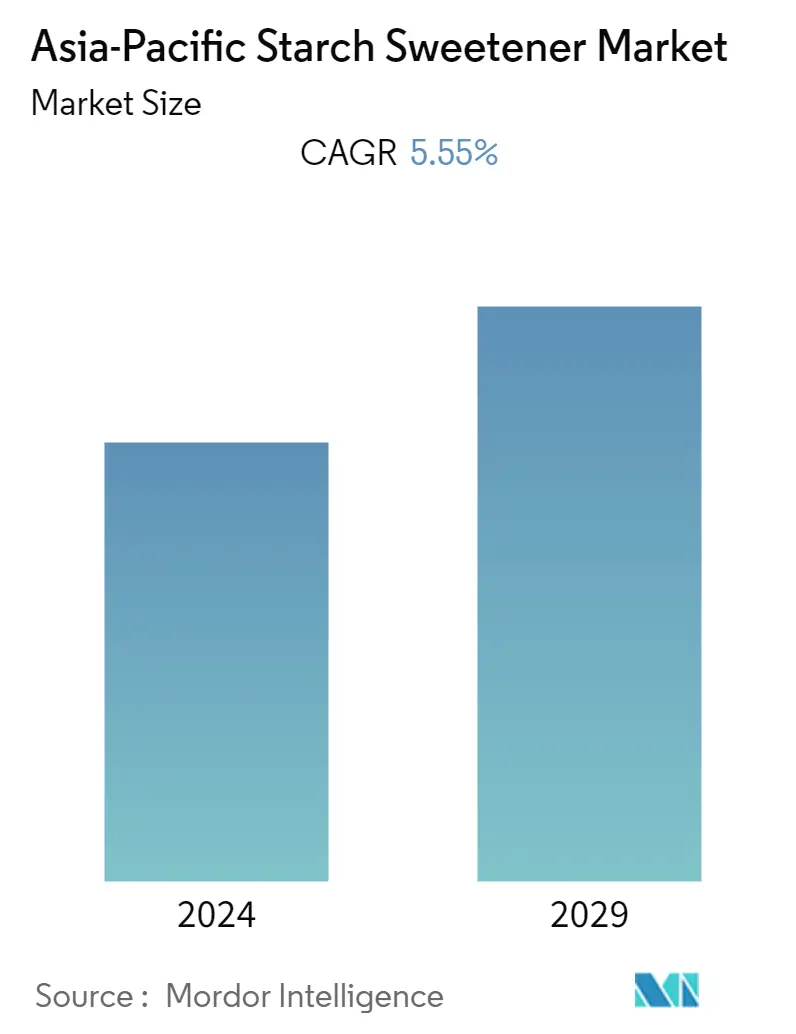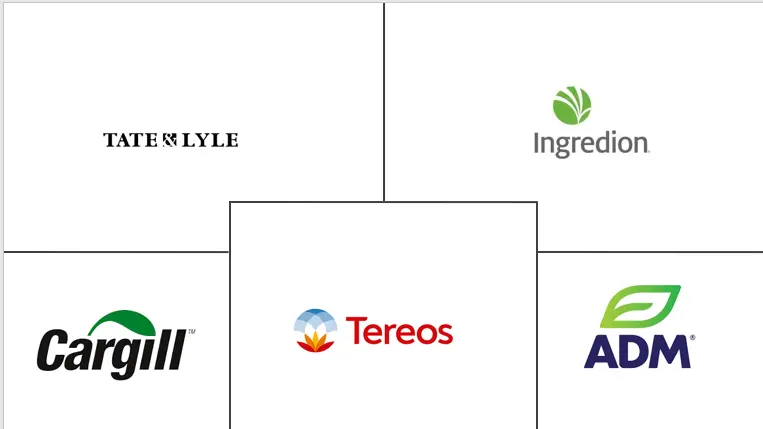Market Size of Asia-Pacific Starch Sweetener Industry

| Study Period | 2019 - 2029 |
| Base Year For Estimation | 2023 |
| Forecast Data Period | 2024 - 2029 |
| Historical Data Period | 2019 - 2022 |
| CAGR | 5.55 % |
| Market Concentration | Low |
Major Players
*Disclaimer: Major Players sorted in no particular order |
APAC Starch Sweetener Market Analysis
Asia-Pacific Starch Sweetener Market is projected to grow at a CAGR of 5.55% during the forecast period 2020-2025.
- The inclination toward low-calorie sweetener and low-calorie beverages, such as diet coke and low-calorie drinks, and low-calorie foods, such as yogurt, ice cream, and grain-based desserts, has gained popularity in the region. The physiology of sweetness receptors is also being studied in greater detail, and to the depths that is unprecedented, with an endeavor to make food and beverages sweet without using sugar.
- Moreover, the replacement of sugar with low-calorie sweeteners, such as aspartame and stevia can reduce the calorie intake, and thus, help in weight and blood sugar level management. This may create a huge gap in terms of demand for starch sugars, thus, hampering the market growth.
APAC Starch Sweetener Industry Segmentation
Asia-Pacific starch sweeteners market is segmented by product type, application, and geography. By product type, the market studied is segmented into dextrin, fructose, high-fructose corn syrup, glucose syrup, and sugar alcohols. The sugar alcohol segment is further sub-segmented into Sorbitol, Maltitol, Xylitol, Erythritol, and Other Sugar Alcohols. By application, the report analyzes bakery, dairy and desserts, meat and meat products, soups, sauces, and dressings, beverages, confectionery, dietary supplements, and other applications. Furthermore, the report takes into consideration the market for starch sweeteners in established and emerging economies of the region, including India, China, Japan, Australia, and the rest of Asia- Pacific.
| By Product Type | |||||||
| Dextrin | |||||||
| Fructose | |||||||
| High-fructose Corn Syrup | |||||||
| Glucose Syrups | |||||||
|
| By Application | |
| Bakery | |
| Dairy and Desserts | |
| Beverages | |
| Meat and Meat Products | |
| Soups, Sauces, and Dressings | |
| Confectionery | |
| Dietary Supplements | |
| Other Applications |
| Geography | |
| India | |
| China | |
| Japan | |
| Australia | |
| Rest of Asia Pacific |
Asia-Pacific Starch Sweetener Market Size Summary
The Asia-Pacific starch sweetener market is experiencing a notable shift driven by the growing consumer preference for low-calorie sweeteners and beverages. This trend is largely influenced by the increasing awareness of health issues related to sugar consumption, such as obesity and diabetes. As a result, food manufacturers are actively seeking alternatives to sucrose, leading to the widespread adoption of bulk sweeteners and sugar substitutes in various products, including beverages, baked goods, and condiments. The region has seen a surge in new product launches featuring low-calorie sweeteners like Stevia, which are favored for their ability to provide sweetness without the associated calorie intake. This shift is reshaping the market dynamics, as companies strive to meet the demand for healthier food options while navigating the challenges posed by stringent regulations.
In Australia, the starch sweetener market is witnessing robust growth, driven by the increasing demand for natural and clean-label ingredients. The diet-soft drink sector remains a dominant force in the sugar substitute market, with aspartame leading the charge. However, the market's expansion is tempered by regulatory challenges. Major players in the Asia-Pacific starch sweetener market, such as Cargill, Tate & Lyle, and Ingredion, leverage their extensive product portfolios and geographical presence to maintain a competitive edge. These companies are focused on innovation and strategic market expansion to cater to diverse consumer preferences. The ongoing development of sugar alternatives and the rising popularity of starch sweeteners underscore the dynamic nature of the market, as stakeholders adapt to evolving consumer demands and regulatory landscapes.
Asia-Pacific Starch Sweetener Market Size - Table of Contents
-
1. MARKET DYNAMICS
-
1.1 Market Drivers
-
1.2 Market Restraints
-
1.3 Porters Five Forces Analysis
-
1.3.1 Threat of New Entrants
-
1.3.2 Bargaining Power of Buyers/Consumers
-
1.3.3 Bargaining Power of Suppliers
-
1.3.4 Threat of Substitute Products
-
1.3.5 Intensity of Competitive Rivalry
-
-
-
2. MARKET SEGMENTATION
-
2.1 By Product Type
-
2.1.1 Dextrin
-
2.1.2 Fructose
-
2.1.3 High-fructose Corn Syrup
-
2.1.4 Glucose Syrups
-
2.1.5 Sugar Alcohols
-
2.1.5.1 Sorbitol
-
2.1.5.2 Maltitol
-
2.1.5.3 Xylitol
-
2.1.5.4 Erythritol
-
2.1.5.5 Other Sugar Alcohols
-
-
-
2.2 By Application
-
2.2.1 Bakery
-
2.2.2 Dairy and Desserts
-
2.2.3 Beverages
-
2.2.4 Meat and Meat Products
-
2.2.5 Soups, Sauces, and Dressings
-
2.2.6 Confectionery
-
2.2.7 Dietary Supplements
-
2.2.8 Other Applications
-
-
2.3 Geography
-
2.3.1 India
-
2.3.2 China
-
2.3.3 Japan
-
2.3.4 Australia
-
2.3.5 Rest of Asia Pacific
-
-
Asia-Pacific Starch Sweetener Market Size FAQs
What is the current Asia-Pacific Starch Sweetener Market size?
The Asia-Pacific Starch Sweetener Market is projected to register a CAGR of 5.55% during the forecast period (2024-2029)
Who are the key players in Asia-Pacific Starch Sweetener Market?
Cargill Incorporated, The Archer Daniels Midland Company, Tereos SA , Ingredion Inc. and Tate & Lyle PLC are the major companies operating in the Asia-Pacific Starch Sweetener Market.

